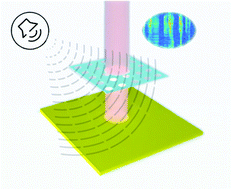A suspended metasurface achieves complete light absorption: a 50 nm-thick optical nanomicrophone†
Abstract
Considerably subtle vibrations can be detected by light signals. Commonly, this is achieved based on the phase change of light that can be attributed to the vibration of a movable mirror, which has been used in gravitational wave detection. For a homogeneous dielectric membrane, the thinner the membrane, the greater the membrane vibration amplitude will be with respect to the sound pressure. However, if the membrane is too thin, most of the light will transmit through the membrane and the sensitivity will be reduced. To resolve this contradiction, we have developed a metasurface membrane with a thickness of only 50 nm but a considerably high reflectivity. This membrane is integrated with a 100-nm-thick gold membrane to form a cavity that can achieve perfect absorption of light. The vibration of the metasurface, which records the sound wave information, can change the light absorption. The noise equivalent pressure of the proposed structure is several orders lower than those of the recently reported optoacoustic detectors, and the alternating current signal response can be enhanced by approximately 1500 times compared with that of a membrane without a metasurface. The integration of nanomechanical oscillators and ultrathin membranes with a metasurface may facilitate future ultrasensitive sound and ultrasonic detection and benefit optomechanic design.



 Please wait while we load your content...
Please wait while we load your content...